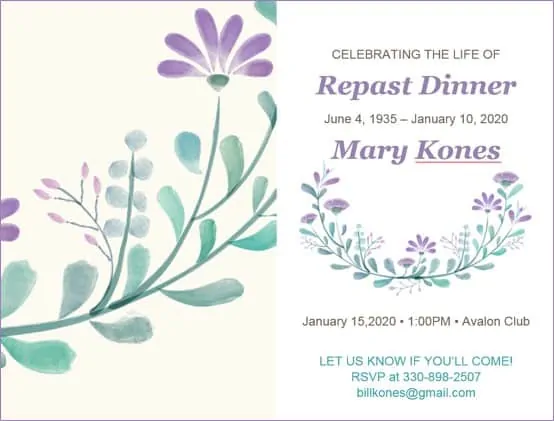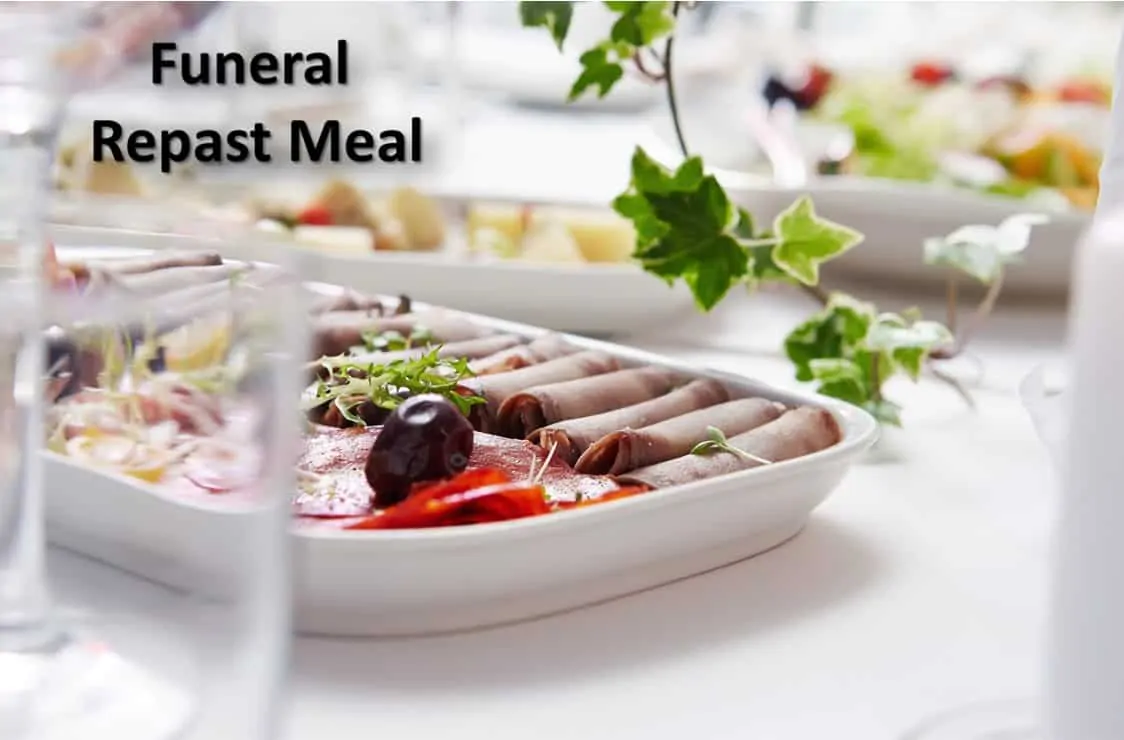What To Know
- A repast is a meal or reception after a funeral or memorial service.
- The purpose of a repast is to provide an opportunity for friends and family to come together and celebrate the deceased’s life.
- There are many different types of repasts, but they typically include food, drinks, and conversation.
- Some repasts are held at the funeral home, while others are held at the deceased’s home or at a restaurant.
- Being respectful and mindful of grieving families and friends is important during a repast.
- Dressing in somber colors is generally considered respectful when attending a repast. This could mean wearing black, navy, or gray.
- If you are close to the deceased’s family, you may want to consider bringing a gift. This could be a sympathy card, flowers, or a donation to a charity in the name of the deceased.
- It is generally considered respectful to keep your words brief and to the point when speaking to the deceased’s family.
- The best way to support the grieving family at a repast is to be there for them.
A funeral repast is an informal gathering after a funeral or memorial service, allowing friends and family to come together, offer condolences, and heal. The event provides a more relaxed and intimate setting for celebrating the deceased’s life and fostering connections among loved ones.
When we experience the loss of a loved one, a funeral ceremony fills several vital needs. Most importantly, a funeral gives a support system for friends and family members. The after-funeral repast is a critical element of the grieving process.
You are able to share fond memories which may assist immediate family and friends in the grieving process.
Gail Trauco. R.N., BSN-OCN- Grief Mediator
A funeral repast is also known as Repass, Funeral Meal, Mercy Luncheon, Meal of Condolence, The First Meal, Dignity Meal, Pominki (поминки), Kokubetsu-Shiki (告別式), Solemn Feast, Stypa.
Benefit of a Repast
When a funeral service is over, people are often left feeling alone, empty and unsure of what to do or where to go. Many tend to stand around and look for support or guidance, not wanting to ‘pack up and leave.’
Planning an after-funeral meal or Repast is essential to the funeral and grieving process. It gives mourners a place to go to and allows friends and family to talk, bond and share their feelings and stories about the deceased.
1) Comfort loved ones and offer support
Part of the grieving process and the healing process is to talk and share feelings. This is sometimes hard to do and harder if one is alone. Attending a Repast gives people an informal opportunity to chat and reminisce about the deceased. People who are shy and not used to public speaking can listen and feel involved. Grieving together goes a long way toward helping the healing process and a Repast offers the opportunity for all to get involved.
2) Allow family members to bond
Family members who have not seen each other for long periods can bond, offer, and gain emotional support at a Repast gathering. This is especially true if family members live far away and have traveled long distances to attend the funeral. The Repast provides a safe place to gather, reflect and share thoughts over a meal.
3) Offer personal condolences to the family
Funerals are never planned and one is often caught unawares. In moments of grief and shock, offering personal condolences to the family and loved ones is sometimes difficult and impossible. At the Repast, the setting is more casual and informal. Mourners will feel at ease approaching the family and offering condolences one-to-one.
4) Celebrate the life of the deceased
Death reminds us that life is important – it is fleeting and can be snatched away at a moment’s notice. Spending time with friends and loved ones is a wonderful way to celebrate the deceased’s life. At a Repast, the process is informal and from the heart. Unlike speeches at the funeral ceremony, gathering at a Repast allows people to speak more freely and without pressure. Many will want to discuss happy episodes they shared with the deceased. Many will recall special moments that they will treasure for years to come. Family can catch up and celebrate the life after one of us has left this Earth.
5) Bring closure to the funeral process
The word Repast means ‘a meal’ and the symbolic process of Breaking Bread is part of many religious ceremonies. By sharing a meal with loved ones and friends, you begin to bring closure to the grieving process. People know that they are loved and cared about and that others struggle with the same grief. After a funeral, people tend to want to talk and not simply climb into their cars and return home to everyday life. The Repast offers an informal and loving setting that closes off the day, no matter how hard it has been.
Repast Invitation
Many people wonder if they are invited to the repast meal. The after-funeral repast invitation is typically sent via email or a printed letter when the funeral repast meal is private.
Sample Repast Invitation:

Repast or Repass?
Generally speaking, when referring to the reception after a funeral repast and repass can be used interchangeably.
According to Webster, the definition of repass is “to pass through, over, or by again,” and the definition of repast is “something taken as food”. However, the Urban Dictionary defines repass as “the gathering with food, occurs directly after the burial or burial ceremony,” and the definition of repast as “family meal or gathering directly following a funeral.”
Cost of a Repast?
The number of people considered in the repast cost breakout is the number of people expected to attend the repast. This number will vary depending on the size of the family and the deceased’s social circle. For example, if the deceased had a large family and a wide circle of friends, the repast may be attended by hundreds of people. In this case, the repast cost would be much higher than if the deceased had a small family and a close circle of friends.
The number of people considered in the repast cost breakout is also affected by the type of food served. A simple repast with sandwiches and coffee will be much less expensive than a full-course meal and alcohol.
| People | Food | Drinks | Venue | Decorate | Staff | Total |
|---|---|---|---|---|---|---|
| 100 | $200 | $50 | $100 | $25 | $50 | $425 |
| 200 | $400 | $100 | $200 | $50 | $100 | $825 |
| 300 | $600 | $150 | $300 | $75 | $150 | $1,275 |
| 400 | $800 | $200 | $400 | $100 | $200 | $1,725 |
Here are some additional tips for keeping costs down:
- Consider having a potluck repast. This is a great way to save money on food costs.
- Have the repast at the home of the deceased. This can be less expensive than having the repast at a funeral home.
- Decorate the space yourself. This can save you money on decorating costs.
- Do not hire staff. You can ask friends and family to help set up and clean up.
- Consider donating any leftover food to a local food bank. This is a great way to give back to the community and reduce food waste.
Repast – Who Pays
The deceased’s immediate family is typically responsible for paying for the repast dinner. However, it’s not uncommon for close friends or extended family members to offer financial assistance or contribute to the event, such as bringing food or helping with the arrangements.
Sometimes, community or religious organizations may also help with the costs or provide a location for the repast. It’s essential to communicate and coordinate with those involved to determine who will cover the expenses and ensure that the event is organized within a budget that works for all parties.
Agreeing on who pays for the repast meal is essential. The post-funeral luncheon can easily exceed $2,000.
Funeral Repast Origin
Looking at the etymology of the term repast, the origin was started in the late 14 century in Old French as “a meal, food” derived from the Latin word repastus meaning “meal.”
Many questions if the term repast is only used in the United States. Surprisingly, repast is used worldwide and France is 20th on the list. Using Google Trends, the top five countries based on popularity are:
- Jamaica
- Trinidad & Tobago
- United States
- United Kingdom
- Australia
Where to Host
After the funeral, people will gather for the repast. Depending on the family, this may be a private or open event for all mourners.
The venue for your repast will have to be decided on before the funeral and communicated to the guests.
Depending on the time of the funeral, you may be serving lunch, dinner, or a mid-day finger meal.
You can hold the repast reception:
This is probably the most convenient venue at the funeral home, as the mourners are already there and won’t need to travel. Many funeral homes have parlors that can hold a large number of people. They also often have staff who will set tables, serve and clean up after the event. The costs of this will have to be arranged beforehand.
At your church – Many people will be familiar with the church or place of worship that the deceased attended. The funeral will often start in the church before moving to the burial place. Guests can return to the church hall after the service to participate in the repast. Many churches have volunteers willing to help set up tables, serve and clean up after the event.
In the deceased’s home – Having your repast at the deceased’s home does bring a very personal note to the event. This is the place where the person lived and will hold many memories. If the family is not up to setting up the repast meal, a relative or close friend may take charge.
At a local restaurant – Choosing the favorite restaurant of the deceased is an option for a repast meal. Arrangements will have to be made with the restaurant to ensure that the tone and mood of the venue are suited for the occasion. The details of the food to be served and the number of people the restaurant can accommodate will also have to be arranged.
In a place of nature – Choosing a place of nature that was special to the deceased can create a beautiful feeling of comfort for the mourners. It can be a park, river setting, mountain venue, or garden. Outdoor venues can be tricky if the weather turns bad, so this must be remembered. You will also have to arrange to transport seating, food, and drinks and get help to set up and clean up after the event.
Planning a Repast
1) Don’t put unnecessary pressure on yourself. You may be grieving or in shock. If you need help from family members or friends to plan the Repast, do not feel bad asking for it. People are always willing to help in situations like this.
2) The choice of venue is up to you. Many Churches and places of worship have community centers, halls or reception areas where you can hold your Repast. Ask your Priest or Pastor for information. You can hold your Repast at your home or at the home of the deceased. A restaurant or hall may be booked if you plan a large affair. You can even plan a Repast in an outdoor park or beach. You should consider what would best suit the personality of the deceased.
3) There are no food rules for a Repast meal. It can range from a sit-down multi-course meal to a simple stand-up buffet. Food can be prepared by a caterer or by the family. You can even ask some close friends to bring a plate of snacks. Remember that some people may be vegan or have allergies, so plan on having a few special dishes for them. Make sure you have tea, coffee, juices and water available.
4) The Repast meal is usually for friends and family. However, you can decide whether to open it to all who have attended the funeral or offer personal invites to selected people. If it is an open invitation, the venue can be announced at the end of the funeral ceremony. If not, ensure the correct people have received invites before the time.
5) Your Repast will cost money and you are under no obligation to spend more than you can afford. You can choose to have a small gathering or a lavish affair – it is entirely up to you. At no stage should the grieving family be put under financial strain.
6) A Repast will essentially be filled with sad and grieving people. But it does provide an opportunity to relax, talk and open up. People will want to share stories about their times with the deceased. The best Repast settings are usually informal and casual. You do not need to go overboard with décor or entertainment. Set out your food, some chairs and tables and allow people to mingle, chat and comfort one another.
Recommend Foods
The choice of food served at a repast meal is entirely up to you. It can be a lavish sit-down meal or a few platters of sandwiches.
The most important thing to remember is that people at the repast will be mourning. They want to chat, meet the family, offer condolences and talk about the deceased. The food is not the main focus. You want to serve up comforting, easy-to-eat food that is wholesome and suitable for all tastes.
Common comfort foods that are popular for a repast meal:
1) Sandwich Platters – Platters work very well. Put them on a table and allow guests to choose what they enjoy. Sandwiches can cater to vegetarians and those with allergies. You can offer a selection for non-meat eaters, including cheese, tomatoes, and egg mayonnaise. For non-vegetarians, offer ham, roast beef, bacon, chicken, and turkey. If you want to add something fancy, go for smoked salmon and caviar.
2 Pasta Dishes – Pasta is a wonderful comforting food. It can be baked before the time and frozen. Prepare vegetarian pasta and meat pasta to cater to all diet types.
3) Chicken – Chicken is another great comfort food. Chicken can be served hot or cold. It can be eaten as finger food, on sandwiches, or as a sit-down meal. A roast chicken with sides of veggies is a great wholesome meal. Children love chicken nuggets. They are easy to eat and don’t make a mess that needs to be cleaned up. Cold chicken on fresh rolls is also a good option when served with a garden salad.
4) Soup – Nothing is more comforting than a steaming soup with fresh bread. People will appreciate the thought, especially in cold weather. You can make carrots, vegetables, tomatoes, mushrooms, chicken, or onion soup. A few choices will cater to all tastes.
5) The Deceased Favorite Dish – If you have the time to create a meaningful experience, preparing the favorite dish of the deceased will be a very emotional thought. This is probably better suited to smaller repast affairs where only the closest family members and friends are present. You must ensure that you have an alternative if guests cannot eat the dish you provide.
6) Desserts – Some people may find desserts frivolous at a repast. Others may find comfort in a home-cooked pudding. There are no rules; you decide what is best for your occasion.
Authors’ Experience
Funeral repasts are tough, but I find them helpful. First, it’s a chance for me to be there for the grieving family. It’s important to show them they’ve got people who care. Plus, we get to share stories about the person we’ve lost, which helps me remember them fully. It’s like a shared space for us all to feel and express our loss together, which helps me handle my sadness. Lastly, it reminds me that life’s short and we’ve got to cherish the people we love. So, while it’s about saying goodbye, it’s also about celebrating life.
Recent Posts
Exploring the pain and hope of saying goodbye through a collection of poems. It can help you to understand your grief and find comfort.
A condolence message is a written expression of sympathy to someone who has lost a loved one. It is a way of offering your support and letting the bereaved know you are thinking of them during this...


